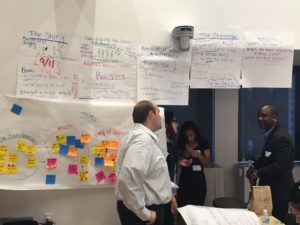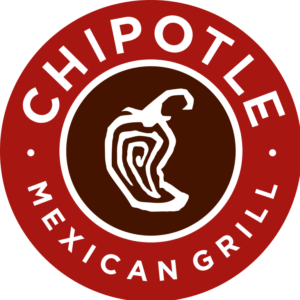Imagine a room with a line of men and women in gray and black suits detailing the play-by-play of their daily work routine. Imagine your students listening and asking questions, but unsure of what questions to ask, likely hearing jargon-y terms that they may not know, and unable to fully understand what these professionals do. This is a the typical Career Day at many schools.
Now, picture a room with professionals from various fields, each one working closely with a group of students over the course of the day. Picture students collaborating with peers from other schools to solve an actual challenge that the professional is facing.
In scenario one, students are spectators and passive participants in career exposure. In scenario two, students are engaged, empathizing with professionals and actively learning about prospective careers. Which would you prefer?
Career Day Meets Real-World Learning
Career Day is a great concept – all too often students’ classroom work does not relate to actual real-world work and students need exposure to different careers early so that they can figure out what makes their heart sing. However, the traditional setup of “professionals share stories, students ask follow-up questions” doesn’t adequately meet the needs of either students or professionals. The professionals do not have a fair chance to paint a realistic picture of their career and students may get just a broad brush picture of the professional’s work.
Moreover, schools within the Schools That Can network have expressed strong interest in more real-world learning support. So, why not extend real-world learning into Career Day?
On May 19, Schools That Can NYC hosted 7th-9th grade students from all across New York City and representing each sector (district, charter, independent) for the first ever Career Day with a Twist. The premier event was inspired by similar events held at Cornerstone Academy for Social Action (CASA) Middle School with #NYCEDU and the Design 4 Impact (d4i) Conference held at Avenues: The World School earlier this year. It was a remix of the traditional career day with a design-thinking component where all 50 students put their teamwork and brainstorming skills to the test. Participating schools included Avenues, CASA Middle School, Central Queens Academy, Cornelia Connelly Center, DREAM, Girls Prep LES Middle School, Hellenic Classical, Metropolitan Lighthouse, The Robert Louis Stevenson School, and VOICE.

Photo taken by Thanassi Karageorgiou
The Twist: Design-Thinking Challenge
Students were placed into 7 groups and assigned a professional who had a job-related challenge. Higher Education, Film/Media, Technology, Law, Entrepreneurship, and Government careers were all represented via organizations including Google, NYU, New York On Tech, Teach For America, The Law Office of Juan C. Restrepo-Rodriguez, the NYC Department of Small Business Services, and Beast of the East Productions LLC. With guidance from STC designated facilitators, which included both education professionals and high school students, students used design-thinking to create a solution to the challenge. Challenges included: How might we create a more sustainable NYC? How might we get students to stop seeing technology through a consumer lens and get more interested in being the inventor/creator of technology? How might we create a better way for young adults ages 18-24 who dropped out of high school to obtain their high school equivalency?

Line up of our career day professionals and facilitators
Empathize
In the first phase, students actively listened to their professional speak about the challenges s/he faces with the goal of understanding the challenge as best as possible from the user’s perspective. Students actively listened to empathize with both sides – the professional and individual(s) who would use the service or product.

Students actively listen to the professional’s challenge
Define
Once students understood the user’s perspective, they worked to clearly define the challenge. In order to understand the issue in its entirety, students focused on the user’s needs in order to develop insights. At the end, students used all information to make suggestions that would have an impact on the users’ experiences.
Ideate
Students busted out markers, chart paper, and post-it notes to share a myriad of ideas without judgement. Facilitators encouraged BIG ideas; this phase is all about creativity, fun, and quantity. Because of the no judgement rule, students can contribute more and think bigger without fear of their ideas being rejected.

The result of an intense brain dump session
Prototype
In the next phase, students worked rapidly to connect ideas together in order to develop a prototype- sketch or model- of their solution. Students pitched their prototype to a panel of judges. Students were then asked questions and given feedback on their prototypes, with the top 3 prototypes awarded based on a set of criteria including creativity, feasibility, relevance to the problem, and collaboration. While all of the prototypes were creative, the NYU-SB, a wristband USB device that carries info on all undergraduate majors at NYU, received top honors to address the challenge of how to help 2nd year college students declare a major so that they can graduate on time and minimize debt.

Some teams created tangible prototypes
Test
Ideally, students would go back to iterate after the test phase. Instead, it’s up to the professionals to test out the prototypes in their workplaces and keep us posted on what develops! The event concluded with students receiving feedback from a panel of judges. STC then announced a winner of the Career Day with a Twist design-thinking challenge.

Students present their prototype to judges for feedback
The Results
All of the students were engaged and welcomed the idea of wanting to do another event similar to Career Day with a Twist in the future. Many of the students described the event as unique, inspirational, fun, enjoyable, creative, amazing, just to name a few. What students enjoyed most was:
- Working in teams
- Making new friends from across the city (other students, other schools, other adults)
- Being able to work on real problems that professionals are experiencing in their work and presenting their solutions to judges
- Creating pitches to share their prototypes
- Having the chance to create something meaningful
School staff also had overwhelmingly positive feedback. All learned new strategies and to improve real-world learning in their schools and most likely implement something they learned from Career Day with a Twist. They appreciated the exposure to the design-thinking process, professionals in various fields and students from other schools/boroughs. It was a great opportunity for young people to help adults solve real problems they’re facing, they loved watching kids collaborate.
Our Gratitude
THANK YOU to…
… all of the school staff, professional guests, facilitators, amazing guest judges, and schools who participated and may have stepped outside of their comfort zones to create an impactful learning experience for our students!
….Teach For America fold hosting us in your beautiful NYC office.

TEACH sculpture from TFA NYC office
…Chipotle for providing us with lunch,

….Brown Coaching and Consulting LLC for leading the networking 101 workshop,

Students did an icebreaker activity as part of Networking 101 session
….and Nas Karas Studios for capturing memorable moments of the day on camera and film.

All of the lovely STC volunteers that helped make the day happen

